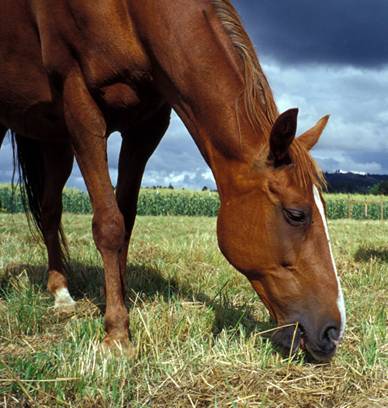 Many people in the horse world have heard the hype about methicillin-resistant Staphylococcus aureus (MRSA) in horses. MRSA can cause infection in horses, just like it can in people, dogs, cats and many other animals. It’s usually what we call an “opportunistic” pathogen, meaning it usually takes advantage of a person or an animal that is already sick or injured, like someone who’s in the hospital and has just had surgery. And because MRSA is resistant to many different antibiotics, the infection can be difficult to treat. The big concern with MRSA in recent years is that infections are now sometimes occurring in people who aren’t sick, and who don’t have wounds or incisions, which is where MRSA usually likes to move in. It’s very important to find out from the start if an infection is being caused by MRSA, so that it can be prevented from spreading to other people and animals, and so that it can (if necessary) be treated with the right kind of antibiotic.
Many people in the horse world have heard the hype about methicillin-resistant Staphylococcus aureus (MRSA) in horses. MRSA can cause infection in horses, just like it can in people, dogs, cats and many other animals. It’s usually what we call an “opportunistic” pathogen, meaning it usually takes advantage of a person or an animal that is already sick or injured, like someone who’s in the hospital and has just had surgery. And because MRSA is resistant to many different antibiotics, the infection can be difficult to treat. The big concern with MRSA in recent years is that infections are now sometimes occurring in people who aren’t sick, and who don’t have wounds or incisions, which is where MRSA usually likes to move in. It’s very important to find out from the start if an infection is being caused by MRSA, so that it can be prevented from spreading to other people and animals, and so that it can (if necessary) be treated with the right kind of antibiotic.
Horses are a bit of a special case when it comes to animals and MRSA. When researchers look at the DNA of MRSA from a dog or a cat, it usually turns out to be one of the common human MRSA strains (usually called a “clone”) from the same area. This means that the dog or cat probably picked up the MRSA from a person somewhere. When researchers look at the DNA of MRSA from horses, however, they often find a different clone, which seems to be more common in horses and people who work with horses than in people in general. A very similar situation has also been discovered in pigs. The worry is that this “horse MRSA clone” can survive in and be transmitted between horses better than the human MRSA clones. That means that in order to control MRSA, just controlling it in the people won’t do the trick – we need to take steps to stop the spread of MRSA in horses specifically as well.
Here are some key points to help reduce the risk of your horse (and you!) getting MRSA:
- Always wash your hands with soap and water (or use an alcohol-based hand sanitizer) after handling a horse, and before handling another horse.
- This is especially important if you have touched a horse’s nose, or any cuts or wounds that the horse may have.
- Don’t go down the row of stalls in the barn and pet every horse on the nose! They love the attention, but this is a great way to spread MRSA if it’s there!
- New horses coming into the barn, or animals coming back from a hospital, should be kept separate from all the other animals and only dealt with after all the other horses, for 3-4 weeks.
- This is an important measure for controlling many infectious diseases, not just MRSA.
- If your horse has a cut that looks infected, cover it with a bandage of some kind and contact your veterinarian. Your veterinarian can culture the wound to determine if it is an MRSA infection.